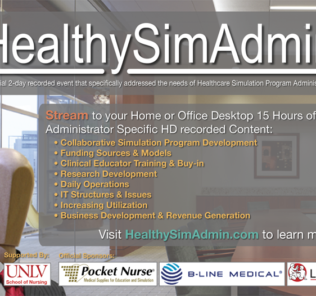Comprehensive Healthcare Simulation Book Covers Operational Management of Sim Program
Healthcare Simulation requires clinical education, training, and patient safety organizations to develop new operational management strategies in-order to maximize simulation program efficiency and effectiveness, as well as to minimize staff burnout. As such, here we take a closer look at Chapter 15 “The Healthcare Simulation Technology Specialist and Management” in the Springer published book Comprehensive Healthcare Simulation: Operations, Technology, and Innovative Practice. This new leading resource for professionals is perfect for starting or expanding their use of the emerging technology to improve clinical outcomes. This chapter was was written by Dr. Amar Patel, DHSc, MS, NRP, CHSE, FSSH, Chief Learning Officer at CAE Healthcare, and Jennifer McCarthy, Experienced Healthcare Simulationist and Educator MA, BS, EMT-P, and supported by editorial work by members of the SimGHOSTS non-profit board of directors.
For the Healthcare Simulation Technology Specialist (HSTS), the technological and simulation environment is constantly changing. Each day there is an advancement in the technology that could help the educational environment grow or force individuals out of a job. It is the job of the HSTS to learn how to help an educational program adjust their curriculum or simply be available to provide insight and perspective. This chapter focuses on defining who can be a leader and what competencies are necessary to be a good leader. In turn, this chapter will provide an overview of how individuals make an educational program successful. It also outline how an HSTS can move forward both personally and professionally.
The success of establishing an educational program is dependent on the effective- ness of the leader, the team, and the environment. It is imperative that either the existing or new leader takes time to understand each of these components. By doing a little bit of homework, the leader will not only understand where the challenges exist but what the program’s strengths and weaknesses are. It is recommended to start by managing and supporting the strengths, while the team works to repair the areas of greatest concern. One of the most significant and notable challenges the leader will face in their first year is pressure. Pressure to be successful. Pressure to understand where to focus and how to make the program successful. Pressure to develop a highly functional team that is independent and driven, and pressure to make the educational program demonstrate a positive return on investment.
Sponsored Content:
Managing the day-to-day operations of a simulation program is not a clinically- oriented task. As noted earlier in this chapter, a leader can be anyone who is willing and capable of achieving the core leadership competencies. Remember, leaders do their homework and are always willing to admit they were wrong. As a simulation leader, the groundwork to advancing a program involves completing a needs analysis of the existing program. By taking a hard look at the current conditions, determining the gaps, and outlining where the future state should be (the want), the leader has an opportunity to develop a plan to take the program from the current state to the future one. In addition to a needs analysis, an HSTS, an educational specialist, or even a program director may feel compelled to reach out to other programs. As a leader, researching best practices, outlining industry standards, and learning from others is key to ensuring the success of the program, and avoiding the folly of others. But which leadership style is best for managing a simulation center?
Coordinating the need for change in the areas that the HSTS manages works well with the transformational leadership style. In this leadership style, the HSTS works with everyone, subordinates and peers, to identify areas needing change. A transformational leader creates a vision to guide the change through inspiration and by executing the change in tandem with committed members of a group [3].
As a transactional leader, self-evaluation and process improvement are key traits and drivers. This style of leadership is considered a managerial style in which, for example, the HSTSs may promote compliance with policy and procedures or facilitate the completion of a managerial task. In this style, the leader may help others choose the right modality for delivering quality education, while guiding and ensuring all members of the team maintain focus and proper perspective.
Situational leadership is about assessing the environment and having the emotional intelligence and political savvy to maneuver and navigate the health- care hierarchical structure. The style utilized by this type of leader is dependent on the situation. Giltinane notes that “the core competencies of situational leaders are the ability to identify the performance, competence and commitment of others, and to be flexible”.
Sponsored Content:
The power of managing a program is driven by using the collective minds of experienced individuals with various backgrounds that may be in your parent organization or on your team. As a result, a leader should seek assistance in developing the program’s mission, vision, values, and aspirational goals. Although it may seem like a simple task, it requires an understanding of the programmatic needs, completion of a needs analysis, development of a business plan, and understanding where the program will be in the next month, next year, or even 5 years into the future.
Previously We Shared Chapter Excerpts on:
- Professional Development Opportunities
- Types of Healthcare Simulation
- Medical Simulation Methodologies
- Finding the Right Simulation Personnel
- Curriculum Development, Integration, and Operations
- The Research Process
- Simulation Center Design
- Defining the Role of a Healthcare Simulation Technology Specialist
- Operating Simulation Audiovisual Technologies
- Educational Constructs
- IT Networks 101
More Key Take Aways From Latest Simulation Operations Book Include:
- Practical guide helps prepare professionals for the broad scope of simulation in healthcare
- Defines the domains of medical simulation operations
- Focuses on the development of the healthcare simulation technology specialist
- Written and edited by leaders in the field of clinical simulation
Written and edited by leaders in the field, Comprehensive Healthcare Simulation: Operations, Technology, and Innovative Practice is optimized for a variety of learners, including healthcare educators, simulation directors, as well as those looking to pursue a career in simulation operations as healthcare simulation technology specialists. Grab your copy today through our affiliate commissioned links:
Get The Soft Cover Here!
Download the eBook Version Now!
Or Get from Amazon!
Lance Baily, BA, EMT-B, is the Founder / CEO of HealthySimulation.com, which he started in 2010 while serving as the Director of the Nevada System of Higher Education’s Clinical Simulation Center of Las Vegas. Lance also founded SimGHOSTS.org, the world’s only non-profit organization dedicated to supporting professionals operating healthcare simulation technologies. His co-edited Book: “Comprehensive Healthcare Simulation: Operations, Technology, and Innovative Practice” is cited as a key source for professional certification in the industry. Lance’s background also includes serving as a Simulation Technology Specialist for the LA Community College District, EMS fire fighting, Hollywood movie production, rescue diving, and global travel. He and his wife live with their two brilliant daughters and one crazy dachshund in Las Vegas, Nevada.
Sponsored Content:

















